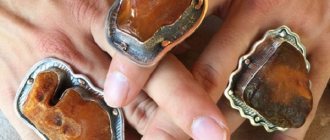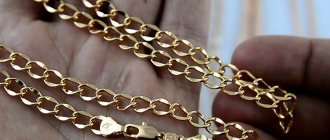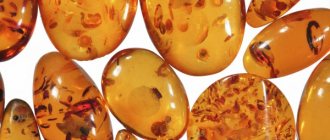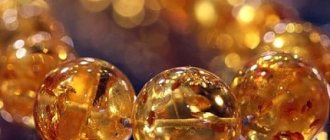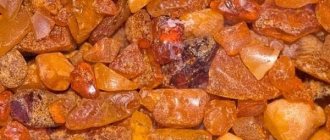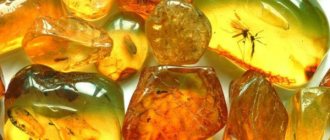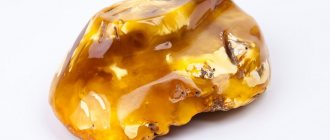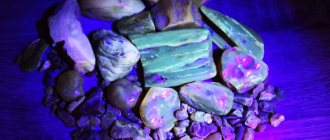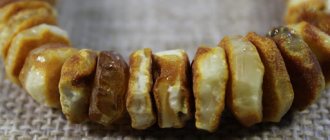Baltic amber is a mineral formed from the resin of ancient trees: species that no longer exist.
- The age of the gem is about 44 million years.
- Geologists called it "succinite".
- The Arabs called this stone “Garn”: they believed that it was hardened dew. Later this name was borrowed by the Romans.
- Because of its ability to become electrified, the Greeks called amber an electron.
- In Ancient Rus' the mineral was called “Ilektron”.
- Amber has many colors and shades; Baltic amber is most often honey-colored.
Grade.
The value of Baltic amber is determined mainly by its color.
Cleanliness also plays a role, although the relationship between it and price is not always straightforward.
Procedures to improve the appearance of Baltic amber are quite common and do not necessarily reduce its value.
Let's look at each of these factors in detail:
Color
The most common color is light yellow to medium dark yellow (usually described as lemon or honey).
There are darker options that have more brownish or reddish undertones, and some pieces are even white and opaque. Baltic amber with blue or green hues also exists, but is very rare.
The most valuable colors are honey, cognac and red. In general, more intense shades are preferred, and pale colors are not as valuable.
Purity
Baltic amber varies in clarity and pieces can range from transparent to completely opaque. Generally, purer samples have an advantage over lower purity.
However, imperfections in amber are not necessarily considered a problem, and if they indicate that it is genuine and ancient, they can make it more valuable.
For example, a product with frozen insects or plants inside can be sold for much more (unless the product is fake, which is often the case).
Improvements
Baltic amber is often treated to deepen its color or improve its clarity, and such procedures do not make it any less authentic.
These treatments are very common and allow you to buy amber that looks great at an affordable price.
The most common method used to enhance the appearance of amber is heating, which usually produces lasting results.
However, you should keep in mind that other methods of enhancing shade, such as different color coatings, do not last long.
There is something called pressed Baltic amber, which is created by fusing small pieces together to form a larger piece.
The resulting amber pieces are cheaper than similar solid pieces of the same size, but pressed amber is also less durable when it comes to pressure resistance.
Fake Baltic amber
Fakes are often made from copal, which is tree resin but not old enough to be real amber.
Glass, plastic, or some non-amber resins are also used to make imitations. However, it is very difficult to detect some of these fakes.
The simplest test to check whether an amber piece is fake is to set fire to part of it (for example, by touching it with a hot needle) and see if the characteristic pine smell of tree resin appears.
However, burning damages the amber and this type of testing is not very practical. Therefore, it is better to have it checked by professionals using special equipment.
To minimize the chance of buying a fake, look for any telltale signs that the amber is not genuine.
First of all, any Baltic amber that appears too cheap is probably not genuine.
If there are also some frozen objects inside the cheap item, such as insects, then it is almost certainly fake (very often, these "frozen" bees or beetles were simply inserted, this happens with expensive items too).
Properties
It has been scientifically proven that amber contains a special acid, which, when in contact with a person, has a positive effect on the body. That is why this variety is used in alternative medicine as a tool for the treatment of certain pathologies. However, Baltic amber is famous not only for its healing properties. According to magicians and esotericists, the magical manifestations of the stone are as effective as healing ones.
Magical
The miraculous influence of amber includes a complex effect on all areas of human life. So, magical properties include:
- protects from negativity;
- amulet from the evil eye and damage;
- attracts love and contributes to the satisfaction of any desires;
- gives joy, health, good luck;
- protects from troubles on a long journey;
- reveals and enhances the natural beauty of its owner;
- gives optimism and tranquility, fills with harmony and love of life.
Medicinal
Entire books can be written about the healing properties of Baltic amber. Its effect on the body has been scientifically proven, therefore jewelry with it is used not only as jewelry, but also in the form of healing instruments that have a positive effect on human health:
- strengthens the immune system;
- calms, helps to concentrate;
- improves blood quality, normalizes blood pressure;
- relieves pain;
- promotes good sleep, relieves depression and blues;
- cleanses the body;
- has a regenerating and anti-inflammatory effect;
- reduces the risk of cancer;
- treats arthritis and rheumatism, as well as diseases of the thyroid gland and respiratory system;
- slows down the aging process of the skin, prevents the appearance of wrinkles;
- neutralizes the negative impact of electrical equipment;
- improves bone fusion;
- has good disinfectant properties.
How to clean and care for precious amber products?
In order for amber to remain the same for a very long time, it is important to know how to care for it.
In order for it to continue to shine, amber must be cleaned frequently. You will receive many compliments while wearing it, but only if it is cleaned properly.
Never use an ultrasonic jewelry machine or steam cleaner. They can damage the amber luster and cause significant damage to the stone.
Use some warm water and a mild soap solution. Place the amber jewels into the solution and use your fingers to wash away any dirt. Dry the stone with a flannel cloth.
To polish amber to a shine, use a drop of olive oil and a soft cloth.
Before storing your amber jewelry, make sure it is cleaned and polished before placing it in your jewelry box.
If the amber is set in yellow gold, sterling silver or even platinum, the instructions are the same. The frame itself can be cleaned separately using appropriate cleaning methods for the specific metal.
Application
Of course, the main use of Baltic amber is the jewelry industry. It is used to create amazingly beautiful jewelry that favorably emphasizes any image and adds individuality and charm to its owner. Earrings, beads, rings, bracelets, necklaces, brooches, hairpins - all these products are inlaid with this resin stone.
In addition to jewelry, Baltic amber is used in many other areas: medicine, industry, decorative arts, cosmetology.
What should you not do when wearing amber jewelry?
Amber is very sensitive, so there are a few things you shouldn't do when you're wearing your favorite amber earrings, necklace, or even ring.
1. Do not leave amber in direct sunlight. If you remove the ring for any reason, please place it in a soft bag to avoid direct rays.
2. Avoid extreme temperatures - too hot or too cold an atmosphere can cause damage to the stone.
3. Apply perfume and hairspray before putting on your jewelry. If they get on the surface of amber, it can lose its shine forever.
4. Avoid cooking or cleaning with an amber ring or bracelet. Household chemicals and heat can destroy amber.
Amber is an unusual stone. It is formed in the depths of the earth, and is not as hard as some other stones you are used to carrying. Even though it is in a solid state, this was not always the case because there was once a liquid form. If you are in a situation where you think your stone could be easily damaged, it is best to err on the side of caution and avoid wearing jewelry.
MINING PLACES
The largest deposit of the solar mineral “Palmnikenskoye” is located in Russia on the coast of the Baltic Sea in the village “Yantarny” near Kaliningrad. Every year, up to 500 tons are mined in this place according to the following algorithm:
- To extract stone, a special technique is used, with the help of which a layer of earth is first washed away with a powerful jet.
- In the next step, dredgers move the waste mixture into the sea until a layer of rock containing amber is exposed.
- After this, the amber-bearing mixture is fed with an excavator bucket onto a conveyor, from where it is sent to the factory.
- After rough and thorough washing, the found amber is dried in a calorific oven, then the minerals are sorted.
Coast of Svetlogorsk
Where to find amber in Russia
Deposits of the solar mineral are located on the coast of the Baltic Sea; this body of water washes the territory of Russia in the Kaliningrad region. Many are trying to obtain this stone illegally. In addition, almost every tourist wants to take with them a “piece of sun” found on the shore.
We recommend: All about the AMBER stone
For those who want to feel like a prospector, special excursions are organized at the Palmnikenskoye plant, where you can “get” a souvenir in improvised deposits.
There is a high probability of finding “pieces of sun” on the coasts of Svetlogorsk, Zelenogradsk, Pionersky, and the village of Primorye.
While vacationing on the Baltic coast, you can inexpensively purchase legally mined minerals or products made from them in any store. This is how they bring blue or white amber with them to Moscow or another city, which reminds them of the sea.
Blue amber
How to find amber on the seashore
- Collecting amber, including on the Baltic Sea coast, is prohibited by law, so it is better not to do this, but to calmly contemplate the seascapes, as well as the sights of the Baltic.
- For sport, you can try to find minerals, but do not take them with you, but leave them in place so as not to break the Law.
- It is best to look for amber on the seashore after a storm: small minerals are washed ashore along with debris, the remains of vertebrates, and black algae.
- Among this unsightly accumulation you can see pieces of frozen resin shining in the sun. To do this, you may have to arm yourself with some kind of stick or rake out the garbage with your hands.
- Local prospectors take nets with them, go into the water and shine a flashlight on the accumulation of black algae: if there is amber among them, when an ultraviolet ray is directed at it, the mineral will glow green.
- When using a flashlight, gems are better visible after sunset.
- After a storm, the police sometimes appear on the shore and check with people walking along the beach to see if they have a large amount of amber.
Amber on the seashore
Water tube mining
- Experienced prospectors extract amber in so-called water tubes, which are located on the shore or in the Baltic Sea itself.
- Water tubes are small hollows flooded with water.
- If there are gems in such mines, then the water usually contains blue clay.
- Minerals in such pipes lie at a depth of about 5 meters.
We recommend: NATURAL PEARL vs. ARTIFICIAL
Amber in the forest and near the river
- Amber jewelry is sometimes found in the forests of the Kaliningrad region.
- Prospectors track passages dug by moles.
- If there is blue clay in the soil they bring to the surface, it probably contains solar minerals. To search for stones in such a place, excavations are carried out.
- To find gems along rivers, you need to study the surface of the earth after heavy rains. It is best to search in early spring, when there is no vegetation.
- When going in search of amber, it is worth remembering: collecting and storing such stones is punishable.
Raw amber necklace
Who is suitable according to their zodiac sign?
According to astrologers, Baltic amber has strong fiery energy, and therefore is suitable for signs under the auspices of the element of Fire - Leo, Aries, Sagittarius. The stone will give its owner powerful strength, protect him from troubles, protect him from ill-wishers, promote correct decision-making, and also improve health.
As for the other signs, wearing Baltic amber is not contraindicated for them. In fact, the stone is an excellent amulet for any person, regardless of what month the person was born. Feel free to choose your amulet and wear it with pleasure!
The popularity of Baltic amber is growing
In recent years, opaque yellow beads made from amber mined in the Baltic countries have become very popular. Buying amber has become commonplace, so many of our compatriots are trying to sell amber in order to get good money for it. Interestingly, the price of amber per gram is constantly increasing. Anita Saulite, director of the geology department of the Latvian Nature Museum, is not surprised by this trend, arguing that similar periods when amber was valued more than gold have already happened in history, because this stone began to be exported to southern countries from the 6th century BC. e. It is interesting that the vestments of the pharaohs of Egypt were decorated with Baltic amber, and many of its samples were found in Egyptian tombs built more than 3 thousand years BC. e. Homer also wrote about this stone in his Odyssey: “I brought a necklace to my father’s house - a large electron set in gold.” The Greeks called warm and radiant Baltic amber electron, after the brightest star Electra from the constellation Taurus. In some tribes, Baltic amber was used to pay as money, and in Ancient Rome, a small amber figurine was worth more than a slave. Baltic amber is especially valued in China and other Eastern and Asian countries, and we are talking about an opaque yellow and dark red stone.
Alternative opinion
The well-known Kaliningrad collector of amber (over 3800 units), businessman Yuri Pedorenko, together with the scientist biologist of the AtlantNIRO Federal State Budgetary Institution Efim Kukuev, argue that amber is a product of a global cataclysm that affected the planet 40-50 million years ago. Large-scale earthquakes caused by the fall of comets or asteroids provoked an environmental disaster, as a result of which up to 90% of animal species died, and the entire forest of Eurasia turned into a windfall.
Broken trees, as a result of unusual atmospheric influences, most likely under the influence of high pressure and temperature, release a larger amount of resin, which is simply squeezed out of the wood. Water flows carry resin secretions into the river delta, where the Baltic Sea is located today.
In addition, the inquisitive researcher confidently states that it is a mistake to consider amber to be the resin of only coniferous trees. He claims that most often the amber drops contain not needles, but oak flowers! As proof, he provides more than 300 specimens of amber stones with plant inclusions from his rich collection.
